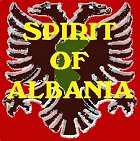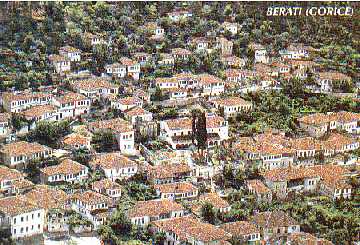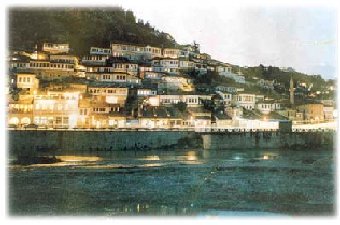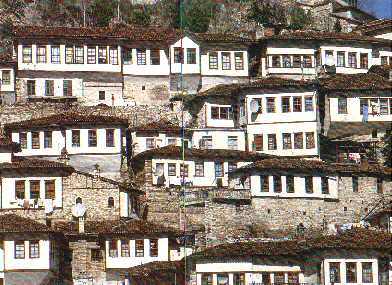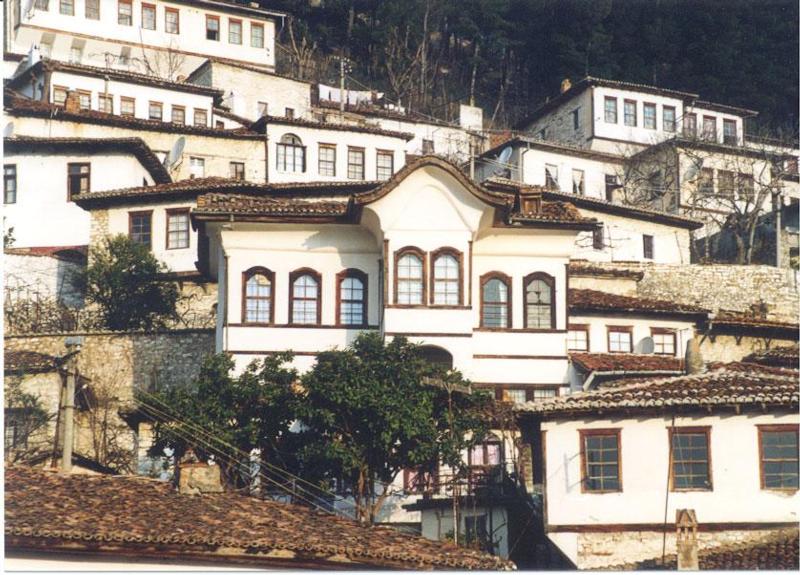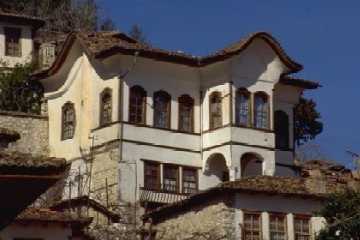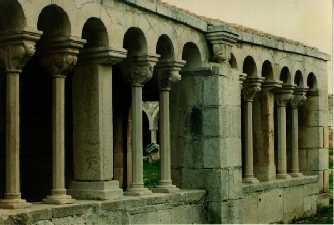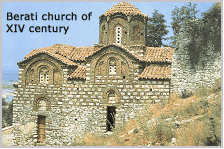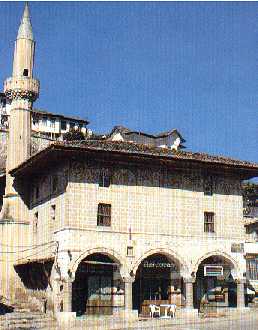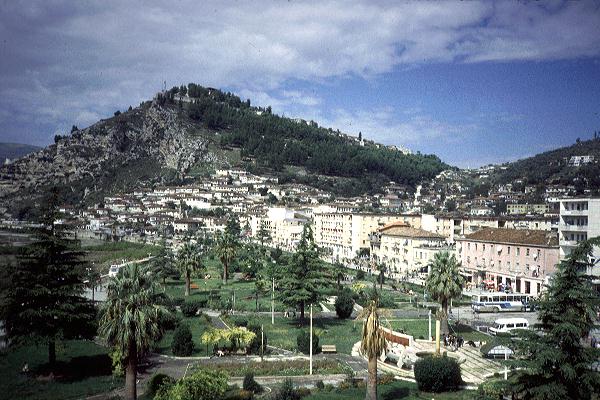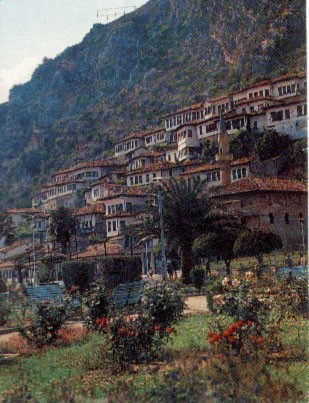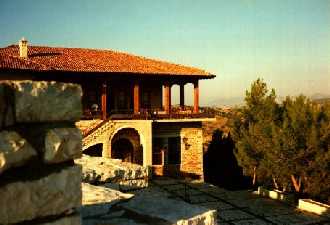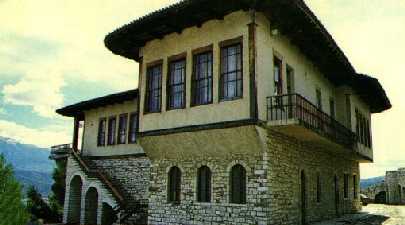|
|
|
Berati
Berat lies on the right bank of the river Osum, a short distance from the point where it is joined by the Molisht river. It is remarkable Ottoman town, with a wealth of beautiful buildings of the highest architectural and historical interest. The pine forests above the city, on the slopes of the towering Tomori mountains, provide a backdrop of appropriate grandeur. The Osumi river has cut a 915-metre deep gorge through the limestone rock on the west side of the valley to form a precipitous natural fortress, around which the town was built on several river terraces.
According to legjend, the Tomorr mountain was originally a giant, who fought with another giant, called Shpirag over a young woman. They killed each other and the girl drowned in her tears, which then became the Osum river.
Mount Shpirag, named after the second giant, is on the left bank of the gorge, above the district of Gorica. Berati is known to Albanians as 'The City of a Thousand Windows' a similar epithet to that sometimes applied to Gjirokastra, The City of Two Thousand Steps, and has a mixture of Orthodox, Muslim and Vlach inhabitants. It was proclaimed a 'Museum City' by the dictator Enver Hoxha in June 1961, and is a UNESCO World Heritage City.
During
the second century B.C. the town was called Antipatrea. it was
a strategic fortress of the Illyrian Dasaretes tribe. In the ninth
century the town was captured by the Bulgarians, who held it until
the eleventh century and renamed it, Beligrad (White City), from
which the name Berat is derived. During the thirteenth century,
it fell to Michael Angelus Comnenus, the despot of Epirus; in
1345 to the Serbs; and in 1450 to the Turks. After the Ottoman
conquest it fell into decline, and at the end of the sixteenth
century had only 710 houses.
What to visit : The Fortress, is built on a rocky hill on the left bank of the river Osum and is accessible only from the south. After being burned down by the Romans in 200 B.C. the walls were strengthened in the fifth century under Byzantine Emperor Theodosius II, and were rebuilt during the 6th century under the Emperor Justinian and again in the 13th century under the Despot of Epirus, Michael Angelus Comnenus, cousin of the Byzantine Emperor. The main entrance, on the north side, is defended by a fortified courtyard and there are three smaller entrances. The fortress of Berat in its present state, even though considerably damaged, remains a magnificent sight. The surface that it encompasses made it possible to house a considerable portion of the cities inhabitants. The buildings inside the fortress were built during the 13th century and because of their characteristic architecture are preserved as cultural monuments. The population of the fortress was Christian, and it had about 20 churches (most built during the 13th century) and only one mosque, for the use of the Turkish garrison, (of which there survives only a few ruins and the base of the minaret). The churches of the fortress were damaged through years and only some have remained.
The Church
of St. Mary of Vllaherna dating from the 13th century, has 16th
century mural paintings by Nikolla, son of the Albania's most
famous medieval painter, Onufri. In a small tree - planted square,
on a hillside inside the walls of the fortress, stands the fourteenth
century Church of the Holy Trinity. It is built in the form of
a Greek cross and has Byzantine murals. Outside the ramparts is
the Church of St. Michael (Shen Mehill), Built in the thirteenth
century. This church is reached by a steep but perfectly safe
path. Near the entrance, after a guardhouse, is the little Church
of St. Theodore (Shen Todher), which have wall paintings by Onufri
himself. The most interesting is the cathedral of St. Nicholas,
which has been well restored and is now a museum dedicated to
Onufri. Onufri was the greatest of the 16th century painters in
Albania. Not only was he a master of the techniques of fresco
and icons, but he was the first to introduce a new colour in painting,
pink, which the French called "Onufri's Red". In addition, Onufri
introduced a certain realism and a degree of individuality in
facial expression. The first inscription recording Onufri's name was found in 1951, in the Shelqan church. The Kastoria church has a date 23 July 1547 and a reference to Onufri's origin : Une jam Onufri, dhe vij nga qyteti i shkelqyer i Beratit (I am Onufri, and come from the town of Berat). Onufri's style in painting was inherited by his son, Nikolla (Nicholas), though not so successful as his father. In Onufri's museum are to be found works of Onufri, his son, Nikolla and other painters'. There are also numbers of icons and some fine examples of religious silversmith's work (sacred vessels, icon casings, covers of Gospel books, etc). Berat Gospels, which date from the forth century, are copies (the originals are preserved in the National Archives in Tirana). The church itself has a magnificent iconostasis of carved wood, with two very fine icons of Christ and the Virgin Mary. The bishop's throne and the pulpit are also of considerable quality. Near the street running down from the fortress is the Bachelors' Mosque (Xhami e Beqareve), built in 1827. This has a handsome portico and an interesting external decoration of flowers, plants, houses, etc. The 'Bachelors' were the young shop-assistants (in practice generally unmarried), whom the merchants in Berat used as their own private militia. The Sultan's Mosque (Xhamia e Mbretit), the oldest in the town built in the reign of Bayazid II (1481 - 1512), is notable for its fine ceiling.
The Leaden Mosque (Xhamia e Plumbit), built in 1555 and so called from the covering of its cupola. This mosque is the centre of the town. The Tekke of the Helveti (Teqe e Helvetive), of 1790, with a handsome porch and a carved and gilded ceiling. Near of tekke was the grave of Shabbatai Zvi, a Turkish jew living in Berat who in the 1660 declared himself to be the Messiah and began a movement that led to hundreds of thousands of impoverished European Jews trying to follow him in an attempted emigration to the Holy Land. The Ottoman authorities put him on trial for disrupting the Imperial Peace and imprisoned for a time in Costantinopole. He was forced to conver to Islam and exiled him back to Albania . After his death his tomb was taken over as a Bektashi shrine and remained that until 1967 More views:
|
